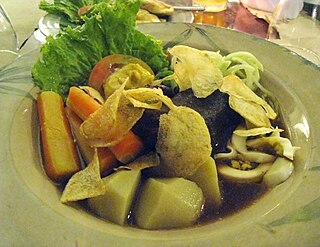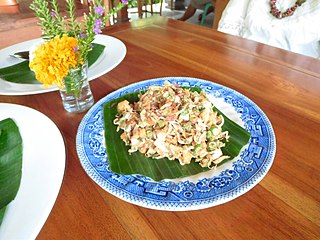
Indonesian cuisine is a collection of various regional culinary traditions that formed in the archipelagic nation of Indonesia. There are a wide variety of recipes and cuisines in part because Indonesia is composed of approximately 6,000 populated islands of the total 17,508 in the world's largest archipelago, with more than 1,300 ethnic groups.

Pecel is a traditional Javanese salad with peanut sauce, usually eaten with carbs.

Peanut sauce, satay sauce, bumbu kacang, sambal kacang, or pecel is an Indonesian sauce made from ground roasted or fried peanuts, widely used in Indonesian cuisine and many other dishes throughout the world.

Fried onions are slices of onions that are either pan fried (sautéed) or deep fried — and consumed as a popular snack food, garnish, or vegetable accompaniment to various recipes.

Lontong is an Indonesian dish made of compressed rice cake in the form of a cylinder wrapped inside a banana leaf, commonly found in Indonesia, Malaysia, and Singapore. Rice is rolled inside a banana leaf and boiled, then cut into small cakes as a staple food replacement for steamed rice. The texture is similar to that of ketupat, with the difference being that the ketupat container is made from woven janur fronds, while lontong uses banana leaf instead.

Javanese cuisine is the cuisine of Javanese people, a major ethnic group in Indonesia, more precisely the province of Central Java, Yogyakarta and East Java.

Mung bean sprouts are a culinary vegetable grown by sprouting mung beans. They can be grown by placing and watering the sprouted beans in the shade until the hypocotyls grow long. Mung bean sprouts are extensively cultivated and consumed in East and Southeast Asia and are very easy to grow, requiring minimal care other than a steady supply of water. They are often used in school science projects.

Lalab or lalap/lalapan (Indonesian) is a Sundanese raw vegetable salad served with sambal terasi. It is a popular Sundanese vegetable dish that originated in West Java and Banten, Indonesia.

Urap is a salad dish of steamed vegetables mixed with seasoned and spiced grated coconut for dressing. It is commonly found in Indonesian cuisine, more precisely Javanese cuisine. Urap can be consumed on its own as a salad for vegetarian meals or as a side dish. Urap is usually found as a prerequisite side dish of Javanese tumpeng, a cone-shaped rice mound surrounded with assorted dishes, as well as part of a nasi kuning dish. In Balinese cuisine, it is known as Urab sayur.

Selat solo is a Javanese dish influenced by Western cuisine; it is a specialty of Solo city, Central Java, Indonesia. It consists of braised beef tenderloin served in thin watery sauce made from a mixture of garlic, vinegar, kecap manis, Worcestershire sauce, water, and spiced with nutmeg and black pepper. It is served with hard boiled egg and vegetables such as string beans, potato, tomato, lettuce, cucumber, cauliflower or broccoli and carrot, and topped with potato chips and some dash of mustard, hollandaise or sauce gribiche on the side.

Plecing kangkung is an Indonesian spicy water spinach dish from the island of Bali and Lombok. Plecing kangkung is made from blanched water spinach leaves and served cold with plecing sambal made from ground red chili pepper, shallot, garlic, bird's eye chili, candlenut, kaffir lime, shrimp paste, salt, and sugar. As a side for the Lomboknese dish Ayam taliwang and Balinese dish Ayam Betutu, plecing kangkung is also usually served with additional ingredients such as bean sprouts, string beans, fried peanuts, and urap's grated spicy coconut dressing.

Ketupat, or kupat, or tipat is a Javanese rice cake packed inside a diamond-shaped container of woven palm leaf pouch, Originating in Indonesia, it is also found in Brunei, Malaysia, Singapore and southern Thailand. It is commonly described as "packed rice", although there are other types of similar packed rice such as lontong and bakchang.

Lawar is an Indonesian dish created from a mixture of vegetables, coconut, and minced meat mixed with rich herbs and spices, originating from Bali, Indonesia. This dish is commonly found in restaurants and warungs in Bali. Despite its rich vegetable mixture, lawar is not a vegetarian dish, since most often it is mixed with minced meat or even blood.

Rujak or rojak is a salad dish of Javanese origin, commonly found in Indonesia, Malaysia and Singapore. The most popular variant in all three countries is a salad composed of a mixture of sliced fruit and vegetables served with a spicy palm sugar dressing. It is often described as tangy and spicy fruit salad due to its sweet, hot and spicy dressing made from ground chilli, palm sugar and peanuts.

Karedok is a raw vegetable salad in peanut sauce from Sundanese region, West Java, Indonesia. It is one of the Sundanese signature dish. It traditionally includes longbeans, cucumbers, bean sprouts, cabbage, legumes, lemon basil, chayotes and small green eggplant, covered in peanut sauce dressing, but there are now many variations. It is very similar to gado-gado, except all the vegetables are raw, while most of gado-gado vegetables are boiled, and it uses kencur, lemon basil and eggplant. Karedok is also known as lotek atah for its fresh and raw version of the vegetable covered with peanut sauce. Karedok is widely served as daily food in the Sundanese family, usually eaten with hot rice, tofu, tempeh, and krupuk. Nowadays karedok can be found in many variation from hawkers carts, stalls (warung) as well as in restaurants and hotels both in Indonesia and worldwide.

Gado-gado is an Indonesian salad of raw, slightly boiled, blanched or steamed vegetables and hard-boiled eggs, boiled potato, fried tofu and tempeh, and sliced lontong, served with a peanut sauce dressing.

Tauge goreng is an Indonesian savoury vegetarian dish made of stir-fried tauge with slices of tofu, ketupat or lontong rice cake and yellow noodles, served in a spicy oncom-based sauce. Tauge goreng is a specialty of Jakarta and Bogor city, West Java, Indonesia. It is usually sold as street food using pikulan or gerobak (cart) by street vendors. It is a popular street food in Indonesia, especially in Jakarta, and Greater Jakarta areas, including Bogor, Depok, Tangerang and Bekasi.

Indo cuisine is a fusion cooking and cuisine tradition, mainly existing in Indonesia and the Netherlands, as well as Belgium, South Africa and Suriname. This cuisine characterized of fusion cuisine that consists of original Indonesian cuisine with Eurasian-influences—mainly Dutch, also Portuguese, Spanish, French and British—and vice versa. Nowaday, not only Indo people consume Indo cuisine, but also Indonesians and Dutch people.
Rujak soto is an Indonesian traditional salad made up of unique blend between beef soto and rujak cingur. A local speciality in which the vegetables rujak served with lontong rice cake in petis sauce poured with soto soup. It is a delicacy of Javanese (Osing) from Banyuwangi, East Java. Generally, rujak soto is served along with es temulawak—that made up of Curcuma zanthorrhiza.


















